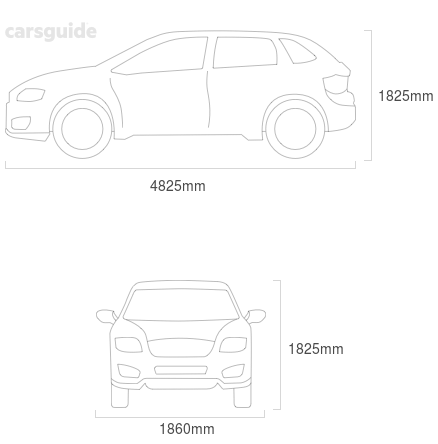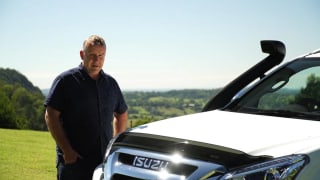
What's on this page
Isuzu MU-X 2017
Carsguide Deputy Editor James Cleary had this to say at the time: The Isuzu MU-X is well-equipped, competent and nicely screwed together. Not as bold or plush as some of its competitors, the top-spec LS-T is all the money, but will appeal to traditional, no-nonsense buyers who prefer an honest, hard worker over a tricked-out flash Harry.
You can read the full review here.This is what James Cleary liked most about this particular version of the Isuzu MU-X: Plenty of grunt, Heaps of space, Trick transmission
The 2017 Isuzu MU-X carries a braked towing capacity of up to 3000 Kg, but check to ensure this applies to the configuration you're considering.
The Isuzu MU-X is also known as the Chevrolet Colorado, the Chevrolet D-Max, the Chevrolet LUV D-Max, the Holden Colorado, the Holden Rodeo, the Isuzu KB, the Isuzu LB, the Isuzu Rodeo, the Chevrolet T Series and the GMC Canyon in markets outside Australia.
Isuzu MU-X 2017 News
Isuzu MU-X 2017 Price and Specs
Pricing guides

| Isuzu MU-X Model | Body Type | Specs | Price from | Price to | |
|---|---|---|---|---|---|
| LS-M (4X2) | SUV | 3.0L Diesel 6 SP SEQ AUTO | $35,750 | $42,570 | |
| LS-M (4X2) | SUV | 3.0L Diesel 6 SP AUTO | $33,770 | $40,260 | |
| LS-M (4X2) | SUV | 3.0L Diesel 5 SP AUTO | $25,630 | $31,680 | |
| LS-M (4X4) | SUV | 3.0L Diesel 6 SP SEQ AUTO | $42,900 | $49,830 | |
Isuzu MU-X 2017 Q&As
Check out real-world situations relating to the Isuzu MU-X here, particularly what our experts have to say about them.
-
My 2021 Isuzu MU-X continually changes gears while towing a caravan
This is probably a simple case of an automatic transmission doing what it’s designed to do. In order to keep the engine in its comfort zone (and making sufficient power and torque to haul the caravan at the speed you’ve chosen) the transmission will shift through its gears to achieve that happy balance.
Any time you encounter a hill or even a headwind (and it’s more so with a heavier caravan) the transmission will assess what speed you want to hold, and then (via changing gears) keep the engine at a speed that supplies the necessary performance. Even a hot day can cause a change in the shift patterns as the transmission aims to take the strain off the cooling system by giving the engine and easier time. Again, a big, heavy caravan will amplify this effect.
However, if the transmission is changing gears for no apparent reason, then you may need to have the calibration checked and perhaps even reprogrammed. Don’t forget, though, that a modern transmission is a pretty clever piece of gear that can even choose to shift down gears going downhill to take the strain of the vehicle’s brakes. Don’t confuse an active transmission with a dud one. And if you still think the behaviour is odd, then an electronic scan of the vehicle might provide more information.
Show more -
Is my 2021 Isuzu MU-X burning too much oil?
Okay, here’s the bottom line: All engines use a little bit of oil. If they don’t there’s either something wrong with the oil pump, or the owner is kidding themselves and not checking the oil level correctly. Modern turbo-diesels also 'breathe' a little oil back through the engine as part of the emissions control system, and owners with an aftermarket catch-can system often find a bit of oil winds up in there instead of being burnt in the engine.
The question is how much is too much. I don’t think 700ml per 2000km is excessive and your dealer’s views will be based on the official figure from Isuzu. But in the real world, owners are reporting oil consumption of around a litre to 1.5 litres per 5000km. At which point, your engine is right on the money.
How you drive the vehicle and whether you tow a heavy load will also affect oil consumption, as will ambient temperature and the type of oil you use. It’s a fact that modern, lower-friction engines are designed to use a little oil in the name of saving fuel, and it’s something car owners need to get their head around. Keep an eye on that dipstick and you should be fine. Checking the oil on a regular basis will also tell you whether the engine’s drinking habits have changed; a much more valuable piece of knowledge to have.
Show more -
Can AEB be turned off in a 2023 Isuzu MU-X?
This is an increasingly common complaint among car owners who are finding that modern driver safety aids such as autonomous emergency braking and lane-keeping assistance programs are too sensitive and don’t take into account the whole picture at the time. Examples include shrubs in a driveway causing the emergency braking to activate, and lane-keeping assistance trying to maintain a car in the centre of its lane despite a looming wide-load on a truck next to it.
I’m not sure what the solution is. But we can only hope that as cars get better and these programs more sophisticated, the errors won’t be as common. But while ever this tech relies on a computer and an algorithm, it will be doomed to (sometimes) fail. This is one of the reasons completely self-driving cars are not yet a reality on our roads; the tech is simply not foolproof yet.
Meantime, covering your car’s cameras with tape might put a stop to the false alarms, but it might also create new problems as the computer searches in vain for the camera’s input. And your concerns about insurance hassles are well founded, too. It’s not hard to imagine the owner of a car with disabled safety features being refused cover in the event of a crash.
Show more -
Why is my 2023 Isuzu M-UX doing so many DPF burns?
My experiences with the very latest turbo-diesel engines available suggests that DPF burn offs are being programmed to happen much more often. It’s likely to be a manufacturer response to the problems associated with DPFs that become clogged and then require manual cleaning or even costly replacement. By programming the DPF to burn off more often, the theory is that this will lead to fewer DPF blockages and other problems, making life easier for the car’s owner and reducing customer complaints.
Perhaps another aspect of this is that the DPF burn usually takes several minutes and kilometres of driving to complete. If the vehicle is stopped before the burn is complete, it may try again for a complete regeneration (burn) as soon as possible, which could be why you’re seeing these frequent notifications on the dashboard.
Show more
Isuzu MU-X 2017 Towing capacity
The Isuzu MU-X has maximum towing capacity of 3000kg. Some models also offer heavy-duty or towing option packs which can increase towing capacity, as well as options which can hamper towing capacity. Towing capacities can vary wildly on a large number of factors. These include engine, transmission, model, and options chosen. Always check with the manufacturer or in your vehicles handbook before attempting to tow anything.
| Isuzu MU-X Model | Body Type | Specs | Braked Capacity | |
|---|---|---|---|---|
| LS-M (4X2) | SUV | 3.0L,Diesel,5 SP AUTO | 3000kg | |
| LS-M (4X2) | SUV | 3.0L,Diesel,6 SP AUTO | 3000kg | |
| LS-U (4X2) | SUV | 3.0L,Diesel,5 SP AUTO | 3000kg | |
| LS-M (4X2) | SUV | 3.0L,Diesel,6 SP SEQ AUTO | 3000kg | |
Isuzu MU-X 2017 Fuel consumption
Fuel consumption for the 2017 Isuzu MU-X is dependent on the type of engine, transmission, or model chosen. The Isuzu MU-X currently offers fuel consumption from 7.9 to 8.3L/100km. The Isuzu MU-X is available with the following fuel type: Diesel.
| Isuzu MU-X Model | Body Type | Specs | Fuel Consumption | |
|---|---|---|---|---|
| LS-M (4X2) | SUV | 3.0L,Diesel,6 SP SEQ AUTO | 8L/100km | |
| LS-M (4X2) | SUV | 3.0L,Diesel,6 SP AUTO | 8L/100km | |
| LS-M (4X2) | SUV | 3.0L,Diesel,5 SP AUTO | 8.1L/100km | |
| LS-M (4X4) | SUV | 3.0L,Diesel,5 SP AUTO | 8.3L/100km | |
Isuzu MU-X 2017 Dimensions
Dimensions for the 2017 Isuzu MU-X are dependent on which body type is chosen. The maximum width and height is 1860mm x 1860mm and can vary on the basis of model.


| Isuzu MU-X Model | Body Type | Height x Width x Length | Ground Clearance | |
|---|---|---|---|---|
| LS-M (4X2) | SUV | 1825x1860x4825 mm | 220 mm | |
| LS-U (4X2) | SUV | 1860x1860x4825 mm | 230 mm | |
| LS-U (4X2) | SUV | 1825x1860x4825 mm | 220 mm | |
| LS-M (4X4) | SUV | 1825x1860x4825 mm | 220 mm | |
Isuzu MU-X 2017 Wheel size
Wheel size for the 2017 Isuzu MU-X will vary depending on model chosen, although keep in mind that many manufacturers offer alternate wheel sizes as options on many models.The wheel size available will alter the range of tyres available to be fitted. Standard wheel sizes on the Isuzu MU-X vary from 16x7 inches to 18x7 inches.
| Isuzu MU-X Model | Body Type | Front Tyre Size | Front Rim | Rear Tyre Size | Rear Rim | |
|---|---|---|---|---|---|---|
| LS-M (4X2) | SUV | 245x70 R16 | 16x7 inches | 245x70 R16 | 16x7 inches | |
| LS-U (4X2) | SUV | 255x65 R17 | 17x7 inches | 255x65 R17 | 17x7 inches | |
| LS-U (4X2) | SUV | 255x60 R18 | 18x7 inches | 255x60 R18 | 18x7 inches | |
| LS-M (4X4) | SUV | 245x70 R16 | 16x7 inches | 245x70 R16 | 16x7 inches | |


